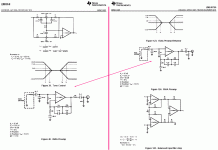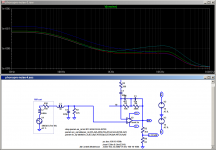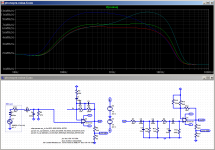Hi,
Elektor Authors seem almost all to be freelancers ..... and You never can be sure if their designs are excellent, mediocre or flawed.
See for example the famous Crescendo amps (possible stability issues, etc.).
I don't have the full text of this phono stage and what the author claimed for his stage.
Anyway its a clear MC-design for low-output MCs to medium/high output MCs.
It probabely just happens, that the noise figures are still low enough for MM useage also.
Its also probable that a stage designed and optimized for MMs could achieve similarly low or lower noise figures utilizing single cheap OPAmps, without paralleling of expensive parts.
Keep in mind, that the needle scratching the vinyl limits the noise figure to less than 67dB, a requirement which is easyly surpassed by the electronics.
In praxis it then doesn't matter if the electronics allow for 75dB or 85dB noise margin, because the difference will only be audible as long as the needle is lifted from the groove.
jauu
Calvin
Elektor Authors seem almost all to be freelancers ..... and You never can be sure if their designs are excellent, mediocre or flawed.
See for example the famous Crescendo amps (possible stability issues, etc.).
I don't have the full text of this phono stage and what the author claimed for his stage.
Anyway its a clear MC-design for low-output MCs to medium/high output MCs.
It probabely just happens, that the noise figures are still low enough for MM useage also.
Its also probable that a stage designed and optimized for MMs could achieve similarly low or lower noise figures utilizing single cheap OPAmps, without paralleling of expensive parts.
Keep in mind, that the needle scratching the vinyl limits the noise figure to less than 67dB, a requirement which is easyly surpassed by the electronics.
In praxis it then doesn't matter if the electronics allow for 75dB or 85dB noise margin, because the difference will only be audible as long as the needle is lifted from the groove.
jauu
Calvin
hi
Ok there are two dominating effect on RIAA amplifier , Noise , Distortion and two secondary effects frequency curve and very low frequency modulation . The "sound" of RIAA preamp is really depending from the design .
LF noise this effect ad some fullness and richness to sound due to record centering and flatness , cell/tone arm resonance , motor noise and stability , suspension and LF feedback . It's the Boomer gig . A fully artificial effect better avoided by a high pass filter minimal 12dB octave 20Hz (there is nothing to listen under this) more slope is better. This is the dark side of vinyl .
Frequency curve must be very precise to reproduce the original sound RIAA is very tricky and an error of 0.3 dB is audible because it's on more that one octave . Channel unbalance cause some coloration and sound stage modification . To obtain the true sound a 0.2 dB matching of the 2 channel versus RIAA curve (100/10000Hz) is a good idea . Not very simple but required .
The noise give a imprecise sound it act like noise shaping from converter and make disappear distortion . A 60/70dB (A) is fully correct vinyl has not much more to give (some 45 RPM direct cut perhaps) but calculated with your cell output . Secondary the tonearm/cartridge assembly is more on the 1% distortion (-40dB) , this dominate the distortion and coloration . MM cartridge (Typical 800 Ohms 0.6mH) thermal noise dominate (not for MC) .
Distortion give a imprecise but punchy and likeable sound , so high figure can give a sound hit . But 0.03% or better is the requirement to obtain an accurate sound.
Yes that all psycho acoustic based requirement , but whee are psycho listener .
reproduction of the cartridge sound .
Ok there are two dominating effect on RIAA amplifier , Noise , Distortion and two secondary effects frequency curve and very low frequency modulation . The "sound" of RIAA preamp is really depending from the design .
LF noise this effect ad some fullness and richness to sound due to record centering and flatness , cell/tone arm resonance , motor noise and stability , suspension and LF feedback . It's the Boomer gig . A fully artificial effect better avoided by a high pass filter minimal 12dB octave 20Hz (there is nothing to listen under this) more slope is better. This is the dark side of vinyl .
Frequency curve must be very precise to reproduce the original sound RIAA is very tricky and an error of 0.3 dB is audible because it's on more that one octave . Channel unbalance cause some coloration and sound stage modification . To obtain the true sound a 0.2 dB matching of the 2 channel versus RIAA curve (100/10000Hz) is a good idea . Not very simple but required .
The noise give a imprecise sound it act like noise shaping from converter and make disappear distortion . A 60/70dB (A) is fully correct vinyl has not much more to give (some 45 RPM direct cut perhaps) but calculated with your cell output . Secondary the tonearm/cartridge assembly is more on the 1% distortion (-40dB) , this dominate the distortion and coloration . MM cartridge (Typical 800 Ohms 0.6mH) thermal noise dominate (not for MC) .
Distortion give a imprecise but punchy and likeable sound , so high figure can give a sound hit . But 0.03% or better is the requirement to obtain an accurate sound.
Yes that all psycho acoustic based requirement , but whee are psycho listener .
reproduction of the cartridge sound .
Last edited:
I'm honestly not too familiar with the behavior of MM cartridges. but thanks for the clarification.
It amazes me though that the Elektor designer wouldn't be aware of that behavior.
Well he wasn't, the current noise of 4 bipolar op-amps in parallel makes no sense at all with MM carts. This stuff has been treated ad nauseum here in numerous threads.
The datasheet I found has a "noise measurement" circuit with an RIAA stage at the front.Does anyone have experience of using RIAA circuits given in the LME 49720 Datasheet by TI ?
Alas its nonsense as the inductance of the source isn't present, its just a 470 ohm resistor, so is going to give results way better than with a real cartridge. Bit shabby that... After all most MM cartridges have about 0.5H of inductance, meaning the impedance rises to tens of kilohms across the audio band.
If you want lowest noise MM RIAA preamp you need an opamp with low current noise, since this is the dominant source of noise for a bipolar opamp in a MM cartridge amp. The NE5534A or a good JFET or CMOS opamp will outperform the LME49720 for noise with such a high impedance source.
Does anyone have experience of using RIAA circuits given in the LME 49720 Datasheet by TI ?
ALL the demo-circuits on the LME49720 sheet are *exact* copies from the much older LM833 sheet.
It should work. Probably won't suck. I'm disappointed they issued the sexy new hi-tech opamp and populated it with old ideas. And especially the RIAA data "can't" be the same one to the other.
Attachments
Last edited:
Thanks very much everybody who responded.
Another small qusetion.
There are two RIAA circuits given in Datasheet of 49720. One with Single Opamp and other one with Two Opamps.
Your valuable ideas would be graetly appreciated. If not what would be the best RIAA for MM cartridge ?
Another small qusetion.
There are two RIAA circuits given in Datasheet of 49720. One with Single Opamp and other one with Two Opamps.
Your valuable ideas would be graetly appreciated. If not what would be the best RIAA for MM cartridge ?
> There are two RIAA circuits given in Datasheet of 49720. One with Single Opamp and other one with Two Opamps.
Where?? (And please *give link*, we are too lazy to Search it out every time.)
Fig 110 is *three* opamps and is a "measurement circuit". After a 1-opamp RIAA it adds two more stages *for test only*, to bring the small hiss up big enough to measure on ordinary meters.
Fig 124 is the RIAA plan you want.
(Fig 123 is mis-labeled, should be "Tone control behavior". Sloppy copy-over.)
Where?? (And please *give link*, we are too lazy to Search it out every time.)
Fig 110 is *three* opamps and is a "measurement circuit". After a 1-opamp RIAA it adds two more stages *for test only*, to bring the small hiss up big enough to measure on ordinary meters.
Fig 124 is the RIAA plan you want.
(Fig 123 is mis-labeled, should be "Tone control behavior". Sloppy copy-over.)
Link for LME 49720 opamp by TI
http://www.ti.com/lit/ds/symlink/lme49720.pdf
Refer Page 2 and Page 33 for two RIAA Circuits.
http://www.ti.com/lit/ds/symlink/lme49720.pdf
Refer Page 2 and Page 33 for two RIAA Circuits.
Page 1 and 33.
The claimed noise performance of the one on page 33 is wrong.
They've clearly ignored the cartridge inductance and the 1.6pA/√Hz current noise going into it. It completely dominates, they ignore it. Perhaps they think current noise doesn't affect reactive components? Whoops.
They also sort of cheat by 6dB by using 10mV as a signal level, rather than the widely used 5mV.
90dB SNR quoted is going to be more like 70dB and easily bested by a bog standard NE5534A circuit with 1/4 of the current noise (0.4pA)
The claimed noise performance of the one on page 33 is wrong.
They've clearly ignored the cartridge inductance and the 1.6pA/√Hz current noise going into it. It completely dominates, they ignore it. Perhaps they think current noise doesn't affect reactive components? Whoops.
They also sort of cheat by 6dB by using 10mV as a signal level, rather than the widely used 5mV.
90dB SNR quoted is going to be more like 70dB and easily bested by a bog standard NE5534A circuit with 1/4 of the current noise (0.4pA)
A litle sim.Page 1 and 33.
The claimed noise performance of the one on page 33 is wrong.
They've clearly ignored the cartridge inductance and the 1.6pA/√Hz current noise going into it. It completely dominates, they ignore it. Perhaps they think current noise doesn't affect reactive components? Whoops.
blue: 4558 (10nV/0.2pA)
green: LM833 (4.5nV/0.7pA)
red: NE5534A (3.5nV/0.4pA)
teal: LME49720 (2.7nV/1.6pA)
Low-frequency performance is approximate as no 1/f knees (enk/ink) were entered, but the table could be extended if so desired.
MM cart values were for an OM10 or something if memory serves (maybe an AT72?).
EDIT: And now same with an A-weighting filter.
Attachments
Last edited:
What happened to Audiojunky13?
Posted for 2 days after joining the forum and hasn't posted since.
There is no answer anyone here can provide to your question.
- Status
- This old topic is closed. If you want to reopen this topic, contact a moderator using the "Report Post" button.
- Home
- Source & Line
- Analogue Source
- RIAA preamp project



 Moved to Analog Source
Moved to Analog Source